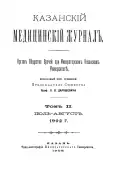Vol 2, No 7-8 (1902)
- Year: 1902
- Published: 10.07.1902
- Articles: 15
- URL: https://kazanmedjournal.ru/kazanmedj/issue/view/2754
Full Issue
To bacteriology of conjunctivitis
Abstract
In the course of the last ten years, in the study of eye diseases, the bacteriological direction has especially intensified. A whole number of researchers, very numerous, among whom in a significant number there are solid scientific names, have devoted their work to the study from the bacteriological point of view of various diseases of the eye, and in particular the more accessible external part of it, that is, conjunctiva and cornea diseases.
 385-393
385-393


Vitiligo in the mentally ill
Abstract
This year's Revue neurologuique describes a few cases of vitiligo in conjunction with the dorsal dryness, namely Ballet and Bauer observed 2 cases of vitiligo et tabes, Souques reported vitiligo of syphilic origin. P. Marie and Gvillain, however, did report 6 patients suffering from vitiligo, but they were not classified as tabes. In view of the venerable authors' interest in vitiligo, the pathogenesis of which has not yet been sufficiently elucidated, we will allow ourselves to say a few words about the case of vitiligo in conjunction with mental illness.
 394-398
394-398


On the application of bed rest for mental illnesses
Abstract
Since psychiatry for a long time has abandoned inhuman ways of imaginary treatment and replaced them with humane compassion and attention to a sick soul, science does not get tired of finding means against mental illnesses. At the present time, the question of bed rest is being interpreted quite energetically with mental suffering.
 399-408
399-408


Assoc. Lyants. Bromocol in itching. "Practical Physician", 1902, No. 4
Abstract
The author tested a new anti-itching-bromocolla cure proposed at last year's German dermatological society's Maх Joseph. Bromocola is a yellowish grey powder that is not soluble in water and in diluted acids, but dissolves in alkalis and is a compound of dibromotannin and glue.
 409-409
409-409


Dr. Kuzmitsky. Orexin tannin as a stimulant of appetite in patients. "Therapeutic Vest.", 1902, No. 1
Abstract
The author warmly recommends tannic acid orexin as an excellent appetite-exciturant and considers it to be a valuable application of therapy that enhances the nutrition of sick people and gives them the opportunity to overcome their sickness.
 409-410
409-410


Dr. Rosenberg. On the pathological anatomy of inadequate muscles in obvious strabismus. Russian Medical Bulletin, 1902, No. 3
Abstract
The issue of pathological and anatomical changes in muscular strabismus still remains poorly understood (mainly due to the difficulty of obtaining a sufficient amount of material for histological examination), despite the fact that the purely clinical side of this suffering is very well developed. This circumstance prompted Dr. Rosenberg to investigate microscopically 8 cases of apparent muscular strabismus.
 410-411
410-411


N. I. Frontkovsky. On the pathological and anatomical changes in the ovaries of animals from ethyl alcohol poisoning. Spb. 1901, Dissertation
Abstract
The question of the influence of alcohol on various tissues of the body is currently occupied not only by doctors, but almost all thinking people, which is quite understandable if we recall the moral harm that this scourge of humanity brings to society. Scientific research on the influence of alcohol on the human and animal organism has appeared in the last ten years, and in addition to laboratory works, 5 volumes of the work of the commission on the issue of alcoholism have already been published.
 411-413
411-413


М. M. Maevsky. Dionine in manic and sexual excitement. Neurologichesky Vestnik, T. X, vol. І
Abstract
Dionin was repeatedly used by the author in the Kazan District Hospital for manic patients and patients suffering from acute confusion, and it turned out that he clearly works beneficially with sexual arousal. The author cites 19 histories of illnesses of persons who received dionin subcutaneously and inwardly in a number of cases of mental agitation, with confusion of consciousness, accompanied by hyperemia of the brain and in a number of cases of increased sexual aspirations.
 413-414
413-414


 414-414
414-414


V. S. Yakovenko. Acute hallucinatory psychosis based on atropine poisoning. Review of Psychiatry, Neurology and Experimental Psychology, 1902, No. 2
Abstract
The author reports on a case of atropine poisoning, expressed in seizures of acute hallucinatory insanity. Due to the fact that it was possible to collect a full anamnesis only after the patient recovered, this case of poisoning proceeded without pharmaceutical intervention and therefore was accessible to observation in all its purity and completeness.
 414-415
414-415


 416-422
416-422


 435-438
435-438


 a3-a8
a3-a8


 a9-a10
a9-a10


 a11-a14
a11-a14











